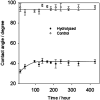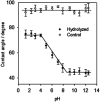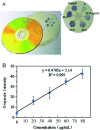A novel biosensor based on Blu-ray disc coating film for determination of total amino acid content in tea leaves
- PMID: 35494145
- PMCID: PMC9044532
- DOI: 10.1039/d1ra07061d
A novel biosensor based on Blu-ray disc coating film for determination of total amino acid content in tea leaves
Abstract
Biosensor substrate materials are a key research focus in the field of sensors. Blu-ray discs (BDs) as universal sensor substrates are advantageous in comparison with other substrates (conventional paper and polycarbonate) in terms of easier activity treatment and higher density of reactive groups on the film surface. In this study, a novel and simple microfluidic biosensor based on BD coating film was developed by treating with sodium hydroxide solution and a piece of filter paper at slightly elevated temperatures. There are no significant physical damages to the substrate morphology, and the aging effect is minimal. The unique wetting, optical, and self-cleaning properties of the modified surfaces can be demonstrated in the paper. We have tested this new type of biosensor substrates for assay applications (the determination of total amino acids in tea leaves), which showed excellent performance in terms of sensitivity and reproducibility. The novel biosensor substrate material based on a simple BD coating film displayed preferable merits with easy making, low cost, easy using, and extensive application prospect.
This journal is © The Royal Society of Chemistry.
Conflict of interest statement
There are no conflicts to declare.
Figures








Similar articles
-
Blu-Ray Discs as Universal Biochip Substrates: Lithography-Free Surface Activation and Assay Patterning.ACS Appl Mater Interfaces. 2019 Oct 9;11(40):37330-37337. doi: 10.1021/acsami.9b13268. Epub 2019 Sep 26. ACS Appl Mater Interfaces. 2019. PMID: 31525871
-
Gold-sputtered Blu-ray discs: simple and inexpensive SERS substrates for sensitive detection of melamine.Anal Bioanal Chem. 2016 Jun;408(16):4403-11. doi: 10.1007/s00216-016-9545-5. Epub 2016 Apr 16. Anal Bioanal Chem. 2016. PMID: 27086022
-
High density microarrays on Blu-ray discs for massive screening.Biosens Bioelectron. 2014 Jan 15;51:109-14. doi: 10.1016/j.bios.2013.07.045. Epub 2013 Jul 29. Biosens Bioelectron. 2014. PMID: 23948241
-
Development of Solution-Processable, Optically Transparent Polyimides with Ultra-Low Linear Coefficients of Thermal Expansion.Polymers (Basel). 2017 Oct 18;9(10):520. doi: 10.3390/polym9100520. Polymers (Basel). 2017. PMID: 30965827 Free PMC article. Review.
-
Recent Progress in Fabrication and Applications of Superhydrophobic Coating on Cellulose-Based Substrates.Materials (Basel). 2016 Feb 25;9(3):124. doi: 10.3390/ma9030124. Materials (Basel). 2016. PMID: 28773253 Free PMC article. Review.
Cited by
-
Extraction of Keratin from Pig Nails and Electrospinning of Keratin/Nylon6 Nanofibers for Copper (II) Adsorption.Polymers (Basel). 2023 Jan 16;15(2):467. doi: 10.3390/polym15020467. Polymers (Basel). 2023. PMID: 36679347 Free PMC article.
References
LinkOut - more resources
Full Text Sources
Miscellaneous

